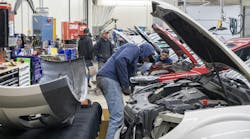Overcoming Obstacles
Mistakes.
Every successful company has made them—a long list of them. Mistakes are an inevitable part of business, and they are an essential rite of passage for every great leader.
“They’re an opportunity,” Marcy Tieger says. “That’s the only way to look at them.”
And Tieger knows: She has built her career off helping shops turn roadblocks into pathways for success. As the managing director for Symphony Advisors LLC, Tieger coaches collision business operators on everything from financial practices to strategic planning to organizational leadership.
A mistake, a problem, an impediment, a restriction, an obstacle—however you want to say it, Tieger says that without them, there would be no innovation, there would be no “ah-ha!” moment that pushes many business owners to find their way to greater success.
Charles Williamson of Paceline Collision Systems, who works with Tieger, and Nick Di Luca of CARS Auto Collision CSN, are proof. Two successful shop operators with two drastically different stories, they each embraced their missteps and helped grow their respective companies to new heights.
Paceline Collision Systems’ Mission to Find its Future
Charles Williamson and the Paceline team took a disjointed company and gave it direction
When it came down to it, a restaurant and a collision repair shop weren’t all that different. Each had its routine. Each provided a daily grind and unique challenges. Both were focused on service.
So, Charles Williamson didn’t have much trouble transitioning from a career running restaurants to becoming a part of the executive team at Paceline Collision Systems, which at that point in 2004 was a three-shop, Texas-based repair operation.
“It’s really kind of that same idea: You have your day-to-day tasks and the focus of serving your customers each day,” he says. “You get in that head-down mode, grinding out each day.”
But, seven years later, when Williamson and the rest of the company’s leadership picked their collective heads up, they didn’t see the company they had envisioned.
Paceline Collision was stuck. Still at three facilities, the company did a more-than-respectable $6.97 million in total sales in 2011. But any growth the company did have was disjointed and unfocused. Decisions were made without any clear vision of the long-term future of the company. The Paceline executive team—Shannon Martin, founder and CEO; Scott McDowell, VP of operations; Lonnie Bear, controller; and Williamson, VP of market development and acquisition—wanted the company to evolve. They wanted Paceline to become leaner, they wanted to improve operations, they wanted grow exponentially, they wanted to become a leader in the Texas market.
They just didn’t know how to do it.
“We all had ideas of where we were heading—I just don’t think we all had the same idea,” Williamson says with a laugh. “We didn’t know who we were as a company. That’s where the mistake was: Without knowing who we were, we didn’t have a clear path for what we wanted to become. We didn’t have a plan. We didn’t have a vision. We were just sort of blindly throwing things out and hoping they found a way to stick. Doing that, there’s no blueprint in place to find the success we wanted.”
Vision, Mission, and Purpose
In 2011, the Paceline executive team did some soul searching. Martin, McDowell, Bear and Williamson went on a retreat of sorts, holding a three-day marathon of a meeting to find a true direction for the company.
For guidance, they had the meeting facilitated (by Symphony Advisors), but the legwork came down to Williamson and the rest really evaluating the company’s—and their own—strengths, weaknesses and opportunities. They saw Paceline as a family-oriented organization, one that offered a true small-business approach to customer service—yet could operate with the sophistication of the nation’s highest-level repair businesses.
But for all of that to shine through in the company’s day-to-day performance, it needed to be formalized.
The team worked to create a vision statement, a mission statement and determine its core values. While it may sound like business-speak, Williamson says it was the most important step the company has taken.
“These ideas and concepts weren’t new to us; it’s who we always felt we were, but we never laid it out and had it in writing as, ‘This is who we are,’” he says. “This strategic planning showed us how we wanted to run the business. It makes everything you do intentional, because now, with planning or goals or issues that come up, you lean back on these values and statements for making decisions. It’s like having guard rails, and everything we do is focused in one direction.”
Plan Turned to Action
Still, as Williamson puts it, there was a lot of work to do.
“The words are easy. It’s the actions that are difficult in how we carry ourselves and how we expect our team members to carry it all out,” he says.
Paceline could outline its vision and purpose down to the tiniest detail, but if it wasn’t carried out by its team each day in the stores, it would be pointless, Williamson says.
They decided to take a top-down approach. Between 15 and 20 of the shop’s higher-up executives and managers (nearly a third of the total staff) took a weekend trip together to a nearby Texas resort. Spouses and families were invited, and the company set up a number of family-centered activities. But at the heart of it, the Paceline group went through a series of meetings, outlining the company’s new focus and the plans for the future.
“We provided babysitters during the meetings, and had spouses attend,” Williamson says. “We want our company to be a family, and so it was important to have family members there to hear it, too. They’re a part of this with their spouses. It affects everyone.”
Buy-in was the key, and the meetings were effective, Williamson says. The goal moving forward was for those who attended the meetings to lead by example and instill the company’s mission and values to the rest of the team.
And the results have been swift. Following its newly focused growth plan, Paceline doubled to six facilities by 2014—each time, entering a market that fit the company’s desires. Overall, the company has improved efficiencies across the board, with total sales ($16.7 million in 2014), car count (600 per month in 2014; up from 280 in 2011) and ticket average ($2,321 in 2014, compared to $2,073 in 2011) all growing at a higher rate than the business’s physical size.
Williamson says the company is seeking further expansion, as well as in-shop operational improvements; just as long as it fits within its overall plan.
The daily grind doesn’t stop, but Williamson says the company now knows what it’s working toward.
“Every effort has a purpose and is part of something bigger,” he says. “Everyone has their heads up and are looking forward—together.”
PACELINE COLLISION SYSTEMS
Vision Statement
Paceline will be a leading collision repair provider in small- to mid-sized markets within the state of Texas. We will accomplish this by investing in the personal growth of our team members, exceeding customer expectations and utilizing innovative processes.
Mission Statement
To restore peace of mind through innovative processes, quality repairs and superior customer service. We create opportunities for our team members through personal development and business growth.
Core Values
Honesty, open communication, compassion in service, humility, continuous improvement, do the right thing, excellence, performance-driven, professionalism
The Birth of CSN—a Nation’s 330-shop Answer to Consolidation
Nick Di Luca saw an industry being swallowed by acquisition, and forged the tools to fight back
Looking back, Nick Di Luca says they should’ve seen it sooner. But, back in 2002, Di Luca had the same mindset many shop owners did—whether it was in his Burlington, Ontario, area or anywhere else in North America.
Di Luca spent his career building CARS Auto Collision into a premier independent repair business, one with well-trained staff, the latest in repair equipment and technology, and significant market share. Between its three facilities, CARS performed 30 percent of all collision and glass work in the area.
At this point in 2002, Di Luca had the business he’d dreamed of building, and a young, eager son who would some day be in line to carry it on.
So, it’s easy to see why he may have ignored the signs at first.
It started with one CARSTAR facility popping up in his area. Then a competing shop joined Fix Auto. Then Gerber came in.
In the span of just a couple years, Di Luca’s quiet, suburban-Toronto market changed drastically. And the long-term outlook for his company changed with it.
“When this first started, we didn’t think this would be an issue,” he says. “Then, the [consolidators] started doing really well. We underestimated it at the beginning. We thought we’d automatically win out because of who we were. That changed pretty quick.
“We reached a point where, if things kept going this way, we weren’t going to be around anymore.”
Getting Off the Island
Burlington sits on the western shore of Lake Ontario, not far from Detroit. In terms of Di Luca’s business, though, CARS Auto Collision might as well have been on an island.
Di Luca focused on internal improvement, increased efficiency, excellence in customer service—all critical components of his business’s success. But to that point, he’d done little to guard against a more powerful competitor with a bigger budget and more assets at its disposal.
Now, he needed to find a way to remain competitive.
It started with a simple meeting between Di Luca and four other shop operators in his region (one later dropped out due to time commitments). They brain-stormed ideas, and eventually developed a plan: They’d create a network of independent repair facilities; funded by membership fees, they’d group together for marketing support, insurance relations and partnerships, vendor agreements, and internal auditing.
This was the start of Collision Solutions Network (CSN).
The original shops agreed to a 50-50 branding split—50 percent of all branding and marketing materials would be dedicated to their private businesses; 50 percent would be for the network.
Initially, Di Luca says this partnership for his business—now CARS Auto Collision CSN—was a boon. He had strength in numbers, he says, which helped him sure-up his already existing relationships with insurers and vendors. It helped him increase his marketing efforts to his existing customer base, as the CSN name started to gain traction regionally.
And the network grew into a full-fledged company, CSN Inc. Today, it has more than 330 members and a corporate office with 16 full-time staffers.
Di Luca still sits on the board for CSN, but focuses on operating his shops.
Beyond the Network
Di Luca says he made a mistake in not recognizing a threat to his business sooner. But from that, he was able to create something that not only put his business in a place to succeed, but also helped the industry as a whole.
“Being a self-standing shop, it’s just so hard to do today,” he says. “We feel we give people a chance to operate in that way, but with some outside support.”
But the lesson here, Di Luca says, isn’t about joining (or forming) a network, it’s about recognizing where the industry is heading and adjusting your business model to meet those needs.
Di Luca sold one of his three locations several years back, but his two remaining shops do roughly the same sales today (just above $6 million annually) that his three did prior. And that 30 percent market share? It’s now closer to 35 percent.
“Every year, every two or three years, there’s something new in this industry we have to adjust to,” he says. “You have to always be ready.”
More with less, that’s Di Luca’s focus. And looking ahead, he’s made a significant investment in his business’s future, becoming the first shop in North America to incorporate Symach technology and equipment, as well as body shop operations and repair philosophies. He’ll switch over one of his two locations this summer with a total investment of roughly $1 million, he says. With increased efficiency and throughput, he says he expects to recoup costs within seven to 10 years.
He’s focused on the future, he says. His son, now 37, is primed to take over, and he wants the business to provide for his son the same way it has for him.
“This is a great industry, and it’s certainly been good to me,” he says. “I have no regrets at all.”
Avoiding the Catastrophic Mistake
Marcy Tieger, managing director of industry consulting firm Symphony Advisors, says that mistakes are inevitable in business—but they don’t have to be crippling, and shops can work to ensure they are able to properly handle the ebbs and flows of business.
“It all comes down to proper planning,” she says.
Make strategic planning a habit. Tieger says to evaluate your business—strengths, weaknesses, opportunities, threats, etc.—every year. Analyze your business partnerships; look at your company’s core values; make tangible goals.
“Your business needs a regular check-up,” she says. “The plan should be a living and breathing thing—something you follow and act out each day, but something that you evaluate and make adjustments to.”
Having this forward-thinking mindset, she says, helps prevent catastrophic mistakes.
The Symach Repair Model
In May, Symach announced that CARS Auto Collision CSN in Burlington, Ontario, would become the first repair shop in North America to incorporate its gas-catalytic drying technology and its FixLine repair process into its facility.
It’ll require a full remodel of the facility, says owner Nick Di Luca, who has invested more than $1 million in the project. The overall goal is to increase efficiency through Symach’s drying equipment, a better-flowing shop layout and an overall dedication to lean processes. With increased throughput, Di Luca expects to recoup his investment within seven to 10 years.
FenderBender profiled gas-catalytic drying technology in February: The Rise of Robotic Drying.




